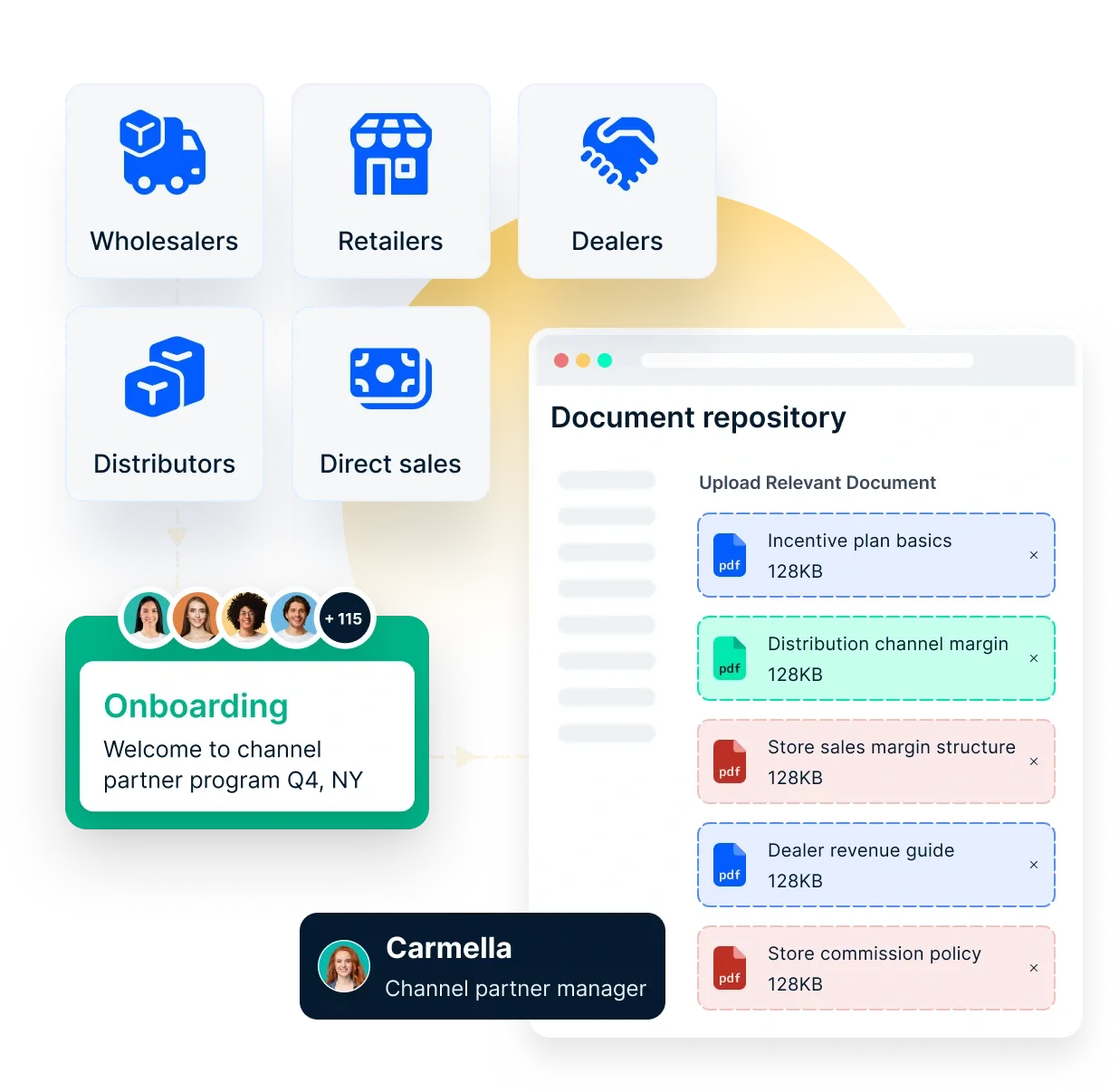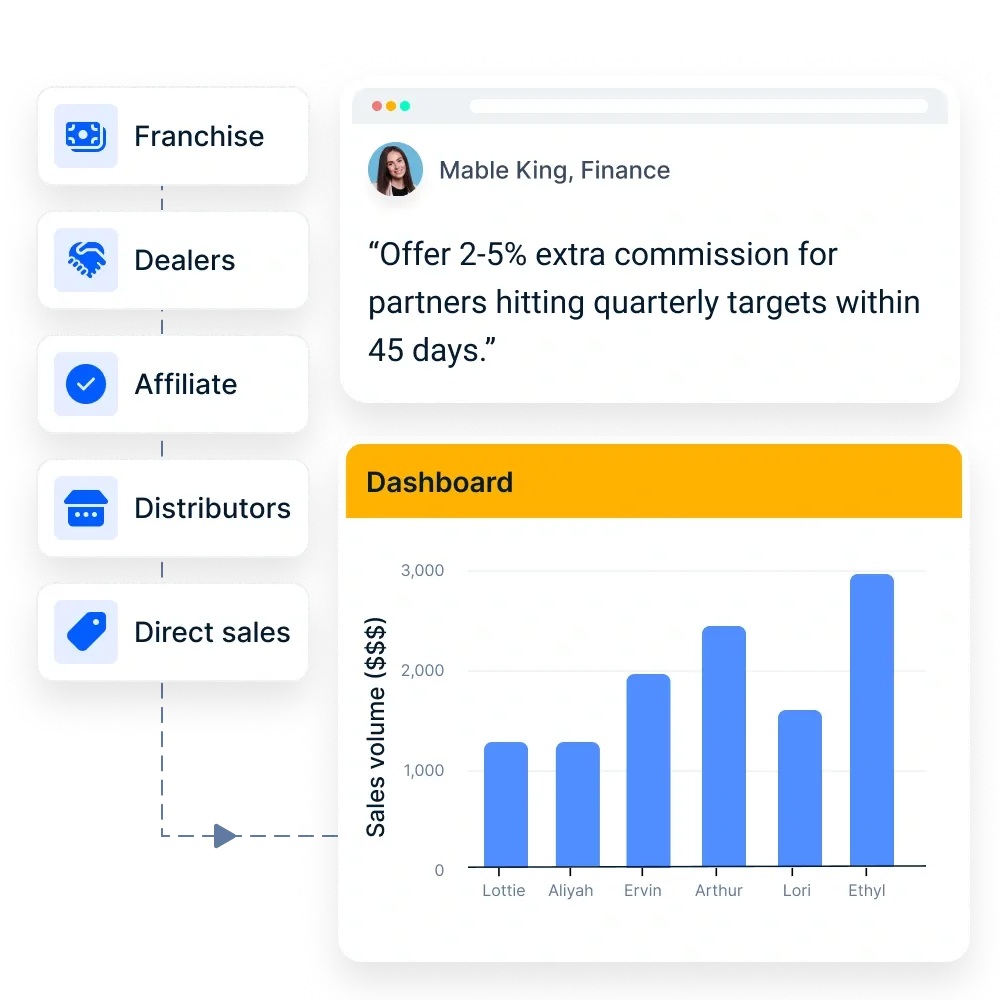Cómo aumentar las ventas del canal en 7 pasos: Estrategias y buenas prácticas
Aprenda a aumentar las ventas de canal con estos cinco consejos eficaces. Desde la identificación de posibles nuevos socios de canal hasta la creación de campañas de marketing que generen resultados, podrás aumentar las ventas de canal y hacer crecer tu negocio.
En esta página
Imagínese lo siguiente: está buscando una solución de software de última generación. En lugar de navegar por las complejidades de la compra directa, consulta con un distribuidor experto que no solo le recomienda el mejor software, sino que también facilita la compra y gestiona las renovaciones de las licencias a través de un servicio de asistencia dedicado.
En este caso, la empresa de software se beneficia de una venta y de unos ingresos continuados sin tener que interactuar directamente con usted, el cliente. Esta es la esencia de la gestión de ventas por canal: utilizar una red de socios para optimizar los procesos de venta y mejorar la experiencia del cliente.
Al alinearse estratégicamente con diversos socios, como revendedores, agentes y proveedores de servicios, las empresas pueden acceder a nuevos mercados y segmentos de clientes con mayor eficacia.
Este blog profundizará mucho más en las ventas de canal y sus estrategias de gestión para que pueda dominar el crecimiento sostenible y obtener una ventaja competitiva.
¿Qué son las ventas por canal?
Surinder Brar es un experto en canales que creó un programa mundial de ventas a través de canales y una estrategia de gestión de socios para Cisco. Según explica, "los vendedores suelen pensar que los canales son una mera extensión de su fuerza de ventas y esperan que se comporten en consecuencia. Esto es fundamentalmente erróneo. El canal no forma parte de su organización y no puede esperar el mismo comportamiento o rendimiento".
En resumen, la venta a través de canales, también conocida como venta a socios, es una forma de venta indirecta en la que una empresa trabaja con socios de canal para llegar a sus clientes. Los socios de canal pueden ser distribuidores, revendedores, concesionarios, personas influyentes, agentes y otros intermediarios.
Las ventas indirectas se realizan a través de terceros intermediarios para llegar a sus clientes. Se trata de mayoristas, minoristas y distribuidores. Las ventas a través de canales entran dentro de las ventas indirectas; las empresas venden a través de terceros. La mayoría de las empresas utilizan una combinación de ventas directas e indirectas para conseguir el máximo alcance.
¿Cómo se relacionan las ventas con los socios del canal?
Los socios de canal son organizaciones o personas que pueden ampliar el acceso de la empresa a una cartera de clientes más amplia. A través de las ventas de los socios de canal, las empresas pueden llegar a clientes que necesitarían ayuda para conseguir.
Los socios del canal son terceros como distribuidores, agentes, consultores, socios afiliados, revendedores, minoristas y proveedores de valor añadido. Todos ellos son personas que venden el producto pero no trabajan directamente para la empresa. Además, Forresterestima que el 75% del comercio mundial fluye por medios indirectos, es decir, a través de socios terceros.... Eso es mucho.
Entonces, ¿cuál es la diferencia entre la venta por canal y la venta directa?
Cuando se habla de ventas por canal frente a ventas directas, es esencial comprender las diferencias fundamentales de enfoque. Las ventas directas se refieren a un modelo en el que una empresa vende sus productos o servicios directamente al cliente final.
Por el contrario, las ventas de canal implican la utilización de equipos de ventas de terceros, a menudo denominados socios de canal, para distribuir y vender productos. Este enfoque puede incluir varios canales de venta, como revendedores, distribuidores y socios de referencia, que ayudan a llegar a un público más amplio.
Conociendo la diferencia entre ventas por canal y ventas directas, hay que saber qué beneficios y ventajas tienen, si se ponen en práctica.
Beneficios y ventajas de la venta a través de canales
Las ventajas de las ventas de canal se centran principalmente en un resultado clave: el crecimiento de los ingresos. Solo en la industria del software, se proyecta que los ingresos por ventas de canal se disparen a 70 mil millones de dólares este año, un aumento significativo de 30 mil millones de dólares en 2019, según lo informado por IDC. Estas son las razones esenciales por las que el éxito de las ventas de canal es cada vez más frecuente:
1. Expansión rápida a nuevos mercados
Al aprovechar los canales de venta asociados, las empresas pueden presentar su marca a clientes fuera de sus redes existentes, lo que permite aumentar las ventas más rápidamente de lo que podría conseguirse con un enfoque de venta directa.
2. Aprovechar la confianza existente
Cuando los clientes han establecido relaciones con sus socios, su credibilidad puede mejorar la reputación de su propia empresa. Esta confianza incorporada puede influir significativamente en las decisiones de los clientes.
3. Aumentar el conocimiento de la marca
Los socios pueden amplificar sus esfuerzos de marketing a través de su propia influencia, ya sea organizando eventos locales, realizando seminarios web o formando a los clientes finales sobre sus soluciones. Esta colaboración mejora su estrategia de canal de ventas.
4. Reducir los costes operativos
Utilizar un modelo de ventas indirectas puede reducir los gastos asociados al mantenimiento de un equipo de ventas directas. Este enfoque permite una asignación más eficiente de los recursos y mejores márgenes de beneficio.
5. Mejorar la experiencia del cliente
Las asociaciones suelen añadir valor al ofrecer productos y servicios complementarios. Esto significa que los clientes pueden disfrutar de una experiencia de compra más integrada sin necesidad de que su empresa desarrolle cada aspecto de forma independiente.
Sin embargo, hay un gran "si" que decide si las ventas por canal le funcionarán.
¿Cómo determinar si el canal de ventas es adecuado para usted?
Aunque tiene muchas ventajas, elmodelo de ventas por canales sólo un enfoque que algunas empresas desearían aplicar. Resulta esencial tener en cuenta muchos factores, como sus márgenes, productos, estado de la empresa, proceso de ventas, procedimiento operativo y otros. ¿Cómo puede determinar si la venta a través de canales es adecuada para usted? He aquí 4 factores importantes:
1. Escala de la empresa y madurez
Las pequeñas empresas que no tienen ingresos suficientes para contar con equipos de ventas dedicados pueden aprovechar las ventas a través de canales para hacer despegar sus productos. Una vez que hayan escalado lo suficiente, un equipo de ventas dedicado puede tomar el relevo o trabajar con socios comerciales.
Las empresas consolidadas pueden utilizar las ventas a través de canales para penetrar en un nuevo mercado. Sin embargo, puede plantear algunos retos.
2. Madurez del producto
A los productos que aún no se han hecho un hueco en el mercado les puede ir bien aprovechar la relación directa con el cliente. De ese modo, los socios del canal pueden ser un lugar excelente para experimentar con características y cambios que lo conviertan en un buen producto a largo plazo.
3. Madurez del proceso de ventas
A menos que tenga un proceso de ventas ajustado a su producto y mercado, no es fácil formar a sus socios de canal. Un proceso de ventas maduro tiene varios elementos, como las partes interesadas del cliente, los desencadenantes de compra, la duración media del ciclo de ventas y otros parámetros calculados. Estas empresas también están en condiciones de formar a sus socios de canal.
4. Ubicación
Las empresas dispersas por varias ciudades pueden obtener buenos resultados adoptando la venta por canal, ya que les ayuda a lanzar una red más amplia y a evitar la designación de varios equipos de ventas.
5. Exigencias de ingresos
Los ingresos son uno de los factores más importantes que hay que tener en cuenta antes de optar por la venta a través de canales. Dado que se tarda un tiempo en establecer un sistema de ventas por canal con socios fiables, hay que intentarlo en función del sector. Para algunos, es mejor empezar con ventas directas y escalar antes de elegir socios de ventas por canal.
Si se cumplen todos estos criterios, debe saber que estas ventas por canal presentan algunos inconvenientes.
3 inconvenientes de la venta por canal para perfeccionar su estrategia de gestión
Aunque una estrategia de ventas a través de canales puede ser muy eficaz, también presenta varios retos que las empresas deben sortear. He aquí algunos escollos comunes y estrategias para contrarrestarlos:
1. Menos control sobre la experiencia del cliente
En un modelo de ventas de canal, sus socios representan su marca ante el cliente final, lo que significa que usted tiene un control limitado sobre sus interacciones. Para mitigarlo, céntrate en ofrecer una experiencia excelente al socio.
Cuando los responsables de ventas del canal se aseguran de que los socios están bien respaldados y equipados con herramientas de marketing, a menudo se traduce en una experiencia de cliente superior para el público objetivo.
2. Conocimiento limitado de los clientes
Las ventas indirectas a través de socios pueden dar lugar a una falta de visibilidad sobre quién compra sus productos. Para solucionar este problema, ponga en marcha procesos de registro de productos. Esto le permite crear una conexión directa con los clientes finales una vez que registran sus productos.
Al recopilar datos de los clientes en esta fase, puede encuestarlos para descubrir necesidades no satisfechas y asegurarse de que sus programas de ventas por canal satisfacen eficazmente las expectativas.
3. Posibles conflictos entre canales de venta
Cuando se emplean estrategias de ventas directas e indirectas, pueden surgir conflictos si los socios sienten que compiten con su equipo de ventas directas.
Para minimizar esta situación, establezca directrices claras que definan qué productos se venderán a través del canal de ventas y cuáles se gestionarán directamente. Esta claridad ayuda a evitar confusiones y fomenta unas relaciones más sólidas con los socios.
Al comprender estos retos y aplicar estrategias específicas, las empresas pueden mejorar el rendimiento de sus ventas a través del canal e impulsar el crecimiento de los ingresos mediante una colaboración eficaz tanto con los nuevos socios de ventas del canal como con los clientes existentes.
7 estrategias eficaces para aumentar las ventas del canal e impulsar el crecimiento de los ingresos
Las estrategias de ventas a través de canales desempeñan un papel crucial a la hora de impulsar el crecimiento del negocio. Deben integrarse con un análisis exhaustivo de la dinámica del mercado, realizado tanto por los equipos de marketing como de ventas, para identificar las mejores prácticas, los factores clave y los pasos necesarios para mejorar los resultados. He aquí siete estrategias eficaces para aumentar el rendimiento de las ventas de canal de su organización:
1. Garantizar la disponibilidad de material de marketing y ventas
En las ventas de canal, equipar a sus socios con las herramientas adecuadas es esencial para su eficacia. Esto incluye proporcionar kits de ventas para revendedores y materiales de marketing adaptados al público objetivo.
- Material de marketing: Los equipos de marketing generan clientes potenciales para las ventas del canal. Unos activos de marketing eficaces no solo dan a conocer los productos de la empresa matriz, sino que también ayudan a mantener el control sobre el mensaje de la marca.
- Colateral de ventas: Las herramientas de formación pueden acelerar el proceso de ventas al permitir a los responsables de ventas del canal y a los socios comunicar la propuesta de valor de forma eficaz. Este material puede incluir hojas de datos de la competencia, seminarios web interactivos, guiones de ventas, testimonios de clientes, hojas de especificaciones o estudios de casos.
Contar con material de marketing y ventas bien preparado refuerza significativamente las asociaciones de ventas del canal.
2. Definir programas claros de recompensas e incentivos
Los programas de incentivos son vitales en las ventas de canal, ya que motivan a los socios a optimizar su rendimiento. Aunque muchos socios de ventas de canal cuentan con programas, a menudo pueden carecer de estructura.
Para estos programas de incentivos es esencial definir claramente los parámetros de medición. Establezca expectativas explícitas sobre el rendimiento de las ventas y los ingresos de cada canal de ventas, basadas en una investigación exhaustiva del potencial de cada canal, teniendo en cuenta factores como los clientes potenciales y el potencial de ingresos.
Además, asegúrese de que su sistema de recompensas se ajusta a las actividades mensuales o trimestrales de los socios del canal. Hay que establecer una logística, unos informes y unos análisis adecuados, y comunicarlos eficazmente a todos los socios que participan en las ventas de canal.
Compassuna plataforma integral de gestión de ventas de canal, ayuda a ejecutar un programa eficaz de rendimiento de canal que supervisará cada paso del proceso con resultados probados.

Compass puede mejorar significativamente la gestión de socios de canal al permitir a las empresas crear planes de incentivos de canal complejos y escalables de forma rápida y sin necesidad de conocimientos de codificación, gracias a su intuitivo diseñador de planes sin código. Esta plataforma permite diseñar y lanzar programas de socios de canal personalizados y adaptados a criterios específicos para cada socio, lo que facilita un enfoque más específico.
3. Dar prioridad a la comunicación a todos los niveles
La comunicación eficaz es fundamental para superar los retos habituales en las ventas por canal. La presencia de múltiples partes interesadas puede generar confusión si no se agiliza la comunicación.
Los socios deben tener puntos de contacto claros para cuestiones específicas, promoviendo líneas de comunicación abiertas. Fomentar la comunicación entre canales; por ejemplo, los fabricantes podrían ofrecer ayuda acercándose a los clientes potenciales de los distribuidores como medida de apoyo y no de competencia.
También es crucial ofrecer asistencia técnica para los productos y servicios. Una comunicación abierta y coherente fomenta el éxito de las asociaciones de canal.
4. Aprovechar las oportunidades de promoción cruzada
La promoción cruzada con los socios de ventas del canal es esencial para el éxito mutuo. El éxito de un socio suele traducirse en el éxito de otros miembros de la red. Esto puede implicar la promoción de las campañas de marketing de cada uno en las redes sociales o la conexión a través de redes profesionales como LinkedIn.
El establecimiento de relaciones sólidas a través de la creación de redes puede mejorar la colaboración en las estrategias de ventas del canal, creando una base sólida para las asociaciones.
5. Centrarse en mejorar las relaciones existentes con los socios
Dar prioridad a la calidad sobre la cantidad es vital cuando se pretende aumentar las ventas del canal. Fortalecer las relaciones con los socios actuales puede conducir a una venta más eficaz antes de buscar otros nuevos.
Piense en cómo puede mejorar la eficacia de los socios existentes, del mismo modo que McDonald's aumenta las ventas de artículos adicionales en el punto de venta. Las mejoras incrementales en el rendimiento de los socios pueden generar un aumento significativo de los ingresos con el tiempo.
Compass ayuda a identificar redes de distribución rentables mediante el análisis de las tendencias de los ingresos en los distintos planes de los distribuidores, proporcionando información valiosa sobre la dinámica del mercado. Mediante la utilización de planes tácticos a corto plazo y promociones comerciales, las empresas pueden obtener una ventaja competitiva, garantizando que sus estrategias de canal sean eficaces y adaptables en un entorno de mercado en rápida evolución.

6. Crear una junta consultiva de socios
La creación de una junta consultiva de socios puede facilitar el diálogo continuo con sus socios sobre sus experiencias y puntos de vista sobre la dinámica del mercado que afecta a su rendimiento. Este enfoque colaborativo ayuda a identificar áreas de mejora en su estrategia de canal, al tiempo que celebra el éxito de los socios.
7. Utilizar la tecnología para agilizar los procesos
La implantación de herramientas especializadas puede ayudarle a gestionar eficazmente los datos de los socios a medida que amplía su negocio a través de múltiples canales. Estas herramientas no solo realizan un seguimiento de los ingresos generados por los programas de ventas de canal, sino que también agilizan el pago de incentivos y mejoran la comunicación.
Buenas prácticas para aumentar las ventas del canal
Consejos para crear una estrategia de ventas por canal perfecta
Una sólida estrategia de ventas por canal es clave para una excelente gestión de las ventas por canal. Aquí tienes siete consejos para lograrlo:
1. Atraer a los socios adecuados utilizando contenidos pertinentes y útiles
Publicar contenidos precisos diseñados para dirigirse a sus socios deseados puede contribuir en gran medida a atraerlos. Por ejemplo, si usted es una empresa que fabrica equipos de carpintería y materias primas, la publicación de libros electrónicos con contenidos editados específicamente para el funcionamiento y mantenimiento de maquinaria atraerá a los socios de canal adecuados. Los socios del canal que le reconozcan como autoridad en la materia querrán trabajar con usted para satisfacer la demanda de los clientes.
2. Trabajar sobre las necesidades del socio
Para tener una relación rentable y exitosa a largo plazo, la estrategia de ventas del canal debe funcionar tan bien para sus socios como para usted. Sólo trabajarán con usted si les beneficia en algo. Por tanto, averigua cuáles son sus necesidades y cómo puedes ayudarles a mejorar su negocio vendiendo servicios adicionales, captando nuevos mercados o mejorando el valor de su oferta.
3. Decida el modelo que tendrá su asociación de ventas por canal
El modelo de sus asociaciones puede establecerse de tres formas distintas. En primer lugar, puedes colaborar con tu socio en los productos o servicios que vendes. Por ejemplo, si eres propietario de un centro de servicio de automóviles, tu socio puede gestionar el túnel de lavado de al lado.
En segundo lugar, puedes vender con la ayuda de tu socio. Los grandes almacenes son un buen ejemplo de este tipo de asociación, y a menudo reúnen artículos de una amplia gama de vendedores. Si encuentras a alguien que venda predominantemente en tu nicho, puede ser una gran opción para tu negocio.
En lo que respecta al método de la asociación de ventas por canal, puedes elegir el que mejor funcione para los dos. Las empresas suelen operar en dos o todos los modelos para maximizar sus ventas.
4. Mantenga una línea de comunicación abierta con sus socios
Comunicarse con frecuencia con sus socios les demuestra su dedicación al desarrollo de la relación y el negocio. Si no tienen noticias suyas con frecuencia, es menos probable que muestren interés por su programa.
También se perderían actualizaciones esenciales, las últimas noticias y anuncios estratégicos que crearían ineficiencias en las ventas o baches en el camino. Mantenerse en contacto con los socios de canal a través del correo electrónico, grupos de Facebook, salas de Slack, seminarios web y reuniones en la oficina les mantiene informados y fortalece la asociación.
5. Motive y apoye a sus socios durante todo el proceso
Lo que hace que las ventas de canal sean tan difíciles es que los socios pueden perder la motivación sobre las ventas, y hay poco que se pueda hacer al respecto. A diferencia de sus representantes de ventas a tiempo completo, que pueden ser motivados a través deplanes de rendimiento para cumplircuotas de ventas, los socios con bajo rendimiento pueden ser difíciles de motivar.
Para que sus colaboradores puedan rendir al máximo, proporcióneles material como manuales completos, testimonios de clientes, ejemploscomparaciones con la competenciaguiones, plantillas de correo electrónico, hojas de trucos para el manejo de objeciones y mucho más. Con todo este material estarán tan preparados como sus propios representantes de ventas para vender su producto.
6. Ofrecer recompensas adicionales
Aunque la comisión que ganan es suficiente recompensa, algunas personas necesitan más para motivarse y rendir más. Los sistemas de recompensa adicionales para tus socios con mejor rendimiento pueden crear "supersocios" que aporten mucho valor.
Si trabajas con varios socios, es probable que exista un sistema de niveles para los socios que trabajan a distintos niveles. Así, en función de su nivel, puedes ofrecerles entradas para eventos exclusivos, apoyo avanzado de marketing, consultoría estratégica, un listado premium en el directorio, un artículo en el boletín y mucho más.
7. Aprovechar las plataformas de asociación de canales
Cuando se trabaja con socios de canal a gran escala, las hojas de cálculo no son suficientes para mantener su compromiso. Necesitará una plataforma que pueda tener de forma eficaz a todos sus socios de canal en un tablero donde pueda ver su rendimiento y sus deficiencias y clasificarlos en lágrimas. Con una plataforma de este tipo, es posible conectar plenamente con sus socios de canal e incluso hacerlo divertido mediante la gamificación y recompensas adicionales.
Una plataforma integral comoCompasspuede ocuparse de todas sus necesidades de gestión de ventas de canal y hacerlo en un sencillo panel de control. ¿Necesitan mejorar sus socios? Puede averiguar el problema con los análisis y encontrar la mejor solución. La plataforma también le permite celebrar y mostrar los logros a los demás para que sigan sonando los tambores.
¿Cómo medir el rendimiento de las ventas del canal?
Ahora que ya dispone de una estrategia de ventas a través de canales, es el momento de estudiar cómo medir los resultados de sus esfuerzos. He aquí algunos indicadores clave que muestran eldel canal:
- Previsión de socios para el año: Evalúe los ingresos totales previstos de los socios a lo largo del año.
- Canalización de socios para el trimestre: evalúe las contribuciones trimestrales para comprender el rendimiento a corto plazo.
- Ingresos totales generados: Mide los ingresos totales generados a través de las ventas del canal.
- Cumplimiento de las previsiones: Comparar los resultados de ventas reales con las previsiones.
- Cuadros de mando de liderazgo de socios: Utilice cuadros de mando e informes para visualizar el rendimiento de los socios.
- Retorno de la inversión (ROI) de los fondos totales de marketing: Analizar la eficacia con la que las inversiones en marketing se traducen en ventas.
Poner en marcha una sólida estrategia de ventas a través del canal implica aprovechar el software de gestión de relaciones con socios (PRM) integrado con su CRM. Este enfoque consolida sus datos de ventas, lo que facilita el seguimiento del rendimiento y el establecimiento de objetivos individuales para cada socio. De este modo, puede agilizar su proceso de ventas y mejorar la colaboración con nuevos socios de ventas de canal.
Conclusión con los puntos clave
Aumentar las ventas con los socios de ventas del canal indirecto no es fácil, pero puede lograrse con el tiempo adecuado, atención y un trabajo de base sólido. Estos son nuestros puntos clave para aumentar las ventas del canal:
- Proporcionar a todas las partes interesadas la documentación adecuada, ya sea de ventas o de marketing.
- Asegúrese de que su sistema de recompensas está establecido y considere la posibilidad de utilizar una empresa externa para establecer y gestionar su programa de incentivos de ventas de canal.
- Asegúrese de que dispone de una cadena de mando fácil de entender y de que las líneas de comunicación están siempre abiertas.
- Recuerde que la promoción cruzada de los socios del canal equivale al éxito de todos.
- Céntrese en cultivar las relaciones que tiene con sus socios actuales antes de abordar nuevos canales. Si sigues estos pasos, aumentarás las ventas a través del canal en un abrir y cerrar de ojos.
Compass es la solución de incentivos de ventas y canal perfecta para su empresa. ¿Quiere saber más? Reserve una demostración ahora.
Preguntas frecuentes
1. ¿Cuáles son los 4 canales de venta?
Los cuatro canales de venta principales son la venta directa, la indirecta (a través de socios), la venta en línea (comercio electrónico) y la venta al por menor.
2. ¿Cuál es la diferencia entre marketing de canal y ventas de canal?
El marketing de canal se centra en la promoción de productos a través de varios socios y canales, mientras que las ventas de canal se refieren específicamente a la venta real de esos productos a través de esos canales.
3. ¿Qué es una estrategia de ventas a través de canales?
Una estrategia de ventas de canal describe cómo una empresa se relacionará con sus socios para vender productos de forma eficaz, lo que incluye la captación de nuevos socios, la formación y la aplicación de programas de incentivos.
4. ¿Cuál es un ejemplo de estrategia de canal?
Un ejemplo sería una empresa tecnológica que colabora con revendedores de software para distribuir sus productos, a la vez que les proporciona material de marketing y sesiones de formación para mejorar su capacidad de venta.
5. ¿Qué hace un jefe de ventas de canal?
Un director de ventas de canal supervisa las relaciones con las empresas asociadas, desarrolla estrategias de captación y compromiso de socios y garantiza la alineación entre los objetivos de la empresa y los de sus socios.
6. ¿Cuáles son los 5 pasos del proceso de gestión de canales?
Los cinco pasos suelen incluir:
- Identificación de socios potenciales
- Contratación de nuevos socios
- Incorporación y formación
- Gestión de las relaciones en curso
- Evaluar los resultados y ajustar las estrategias en caso necesario.












